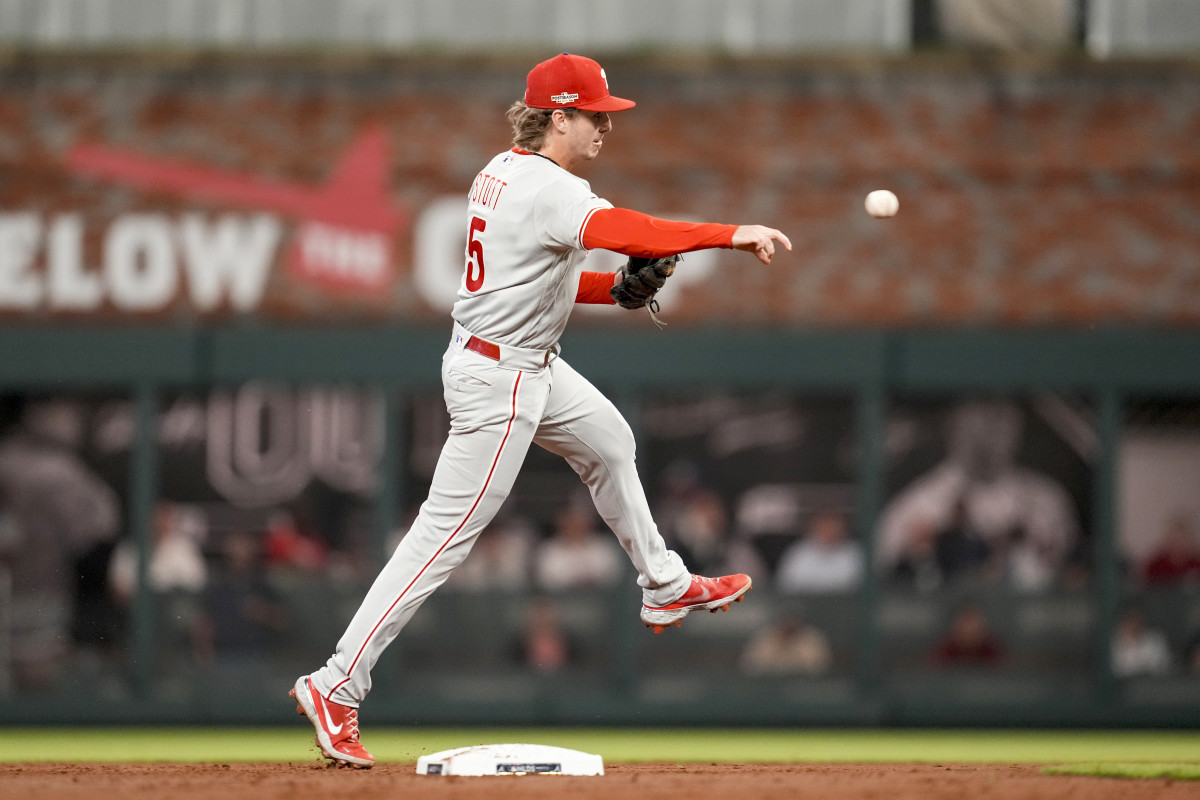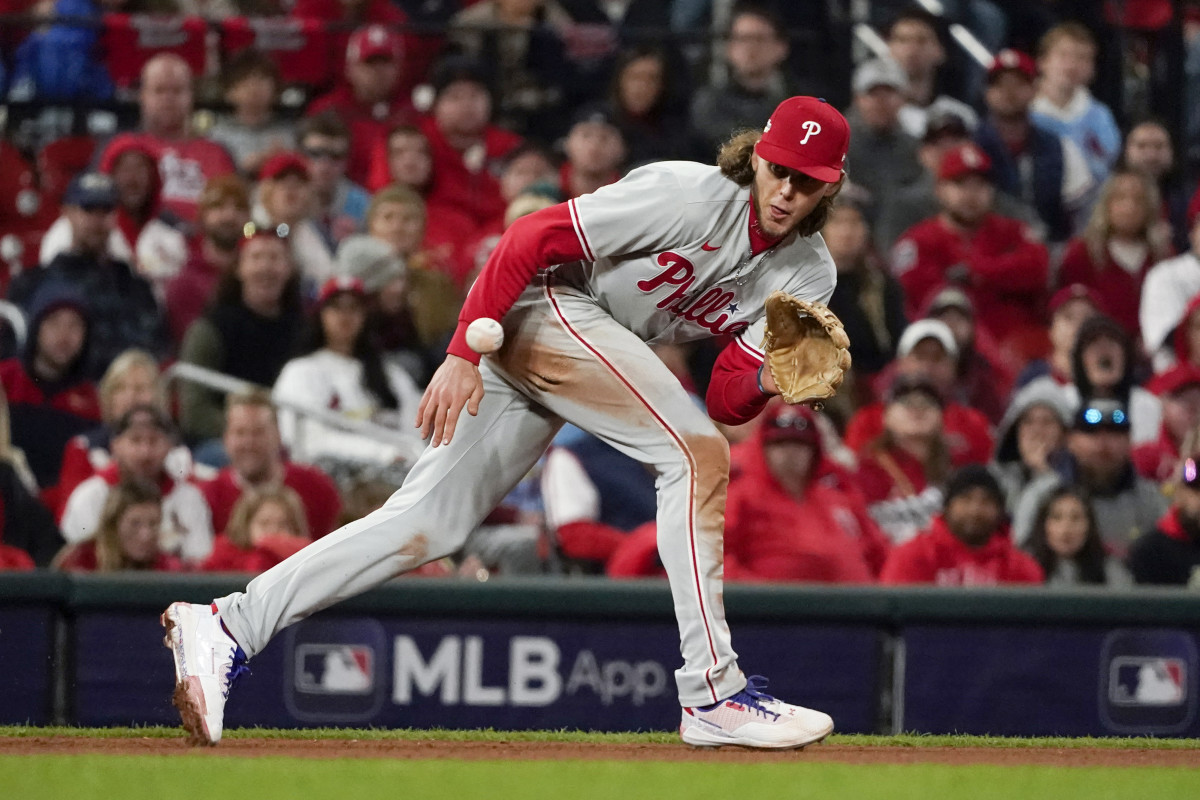How the Phillies’ Woeful Defense Started Making the Routine Plays
SAN DIEGO — The Phillies heard the jokes at the beginning of the year. They read the critiques, and they saw the replays, and they looked up the statistics. But they didn’t need any of that to confirm what they already knew: Their infield defense was dreadful.
It’s still not perfect. (They got a ninth-inning reminder of that in Game 1.) But the jokes no longer really apply in the same way. For those who never updated their original perceptions of this defense, it’s time for a revision: This Phillies infield truly is better than it was at the start of the season.
To start, it’s not quite the same group of players. One weak defender was released (Didi Gregorius), while other, better ones have locked in their playing time (Bryson Stott) or been acquired via trade (Edmundo Sosa). The team has also changed its positioning: While they used the shift heavily in the spring, they did so far less down the stretch, trying to find a strategy that better fit their players. And one of the biggest factors, they say, is the impact of continued time with infield coach Bobby Dickerson.

The veteran coach was hired over the winter specifically to make this group less miserable. He has a phrase for what he’s tried to get from his fielders this year: “playing within their means,” he calls it.
“All I do is ask the guys to be the best version of themselves,” Dickerson says. “Whether you’re slow, fast, great arm or not, whatever. Just be the best version of that.”
That might sound obvious—maybe even too obvious to be worth anything. But the Phillies have found the approach to be genuinely helpful. They saw the opposite during a spring laden with mistakes: When fielders were stressed about trying to extend their range, to make plays worthy of highlight reels, they usually failed. Maybe that shouldn’t have been surprising. After all, this group was assembled for its offense far more than for its defense, and they all were aware of their limitations. But the pressure to improve seemed to be suffocating, rather than encouraging, and the result was a mess. Enter “playing within your means”: Don’t worry about trying to be worthy of a Gold Glove. Just work hard, focus on getting the routine stuff and leave the rest aside.
“You’re always balancing your club,” says Phillies president of baseball operations Dave Dombrowski. “You do the best you possibly can. So sometimes, you look at the overall position, and we always felt that our offense was the strength of what was going to happen in the infield. But we also knew that we hired an outstanding infield coach in Bobby Dickerson, and with the ability we had from the beginning… we knew that we wanted to make the routine plays.”
The Phillies ended up doing just that. Despite the reputation they gained from their flubs in April and May, they dramatically cut down on errors in the second half, and they ended up one of only five teams to finish the year with fewer than 70 errors. (The Phillies had 69; the league average was 86.) Was this infield full of web gems? Not exactly. But it wasn’t full of mistakes in the end, either, a consistency that helped them reach the postseason for the first time since 2011.
That growth also showed in more advanced defensive metrics. In May—when the team bottomed out as a whole—Philadelphia’s infield outs above average was -13. The minus sign in front is probably a tip-off. But just to be clear, yes, that’s bad. The Phillies’ infield that month ranked 28th out of 30 teams. By September? Their infield outs above average was +10. That was good for 11th in MLB: Not elite, no, but much better than it had been and no longer a liability. They weren’t costing the team runs anymore. They were actually saving a few.
This improvement came alongside a change in positioning. In May, Philadelphia used the shift on 35% of pitches. An infield that was already struggling was being asked to play out of its standard place, and even if the strategy made sense on paper, it presented a challenge in its execution. So the Phillies made a change. In September, the percentage of pitches they shifted on went down to 16%.
“As the season has gone on, between our analytics people that are doing the suggestions and Bobby and the players, it’s been a daily adjustment,” said manager Rob Thomson. “We’ve just gotten a little bit better at it, just a little bit at a time.”
Another notable change in that period, of course, was the manager himself. Previous skipper Joe Girardi was fired in the first week of June and replaced by Thomson, first in an interim capacity, now on a multi-year contract. Up and down the roster, players have complimented the environment Thomson has created, one they describe as seeming freer and more open. The change in positioning is part of that, too.
“We were a little more aggressive with [defensive positioning] earlier in the year. Maybe it bit us in some spots,” says third baseman Alec Bohm. “I think we just kind of needed to calm down a little with it… We started playing baseball again, just play the game, see what happens.”
There has been no member of this infield as scrutinized as Bohm. (A three-error game in April, followed by “I f---ing hate this place,” will do that.) But there has been none who have come as far either.
“He hit rock bottom there for a minute,” Dickerson says of Bohm and his defense at the beginning of the season. “But to his credit, he’s worked so dang hard.”

Bohm says his relationship with Dickerson has been essential to getting the most out of that work. Part of that is how comfortable he feels with the coach. “He’s kind of a fool, right? Watch him out here,” Bohm said with a grin during a workout at Petco Park on Monday, pointing from the dugout to the field, where Dickerson was grooving and wisecracking between fungoes. “He’s dancing. He’s just having fun.” That comfort has led to trust. (Which is something the coach has instilled everywhere he’s been. The Phillies hired Dickerson from the Padres, and he left an impact in San Diego, too. “I always enjoyed playing defense, but I never really like fell in love with it and really wanted to go out there and make an impact on the defensive side of the ball,” Padres second baseman Jake Cronenworth said this week. “When he came in and preached about the importance of what we do on the field and how important it is, I think I really started to buy into what he was preaching, and I think it’s helped me tremendously.”) For 25-year-old Bohm, this means he knows the coach has his back, and he’s seen how much that means both when he does well and when he does poorly.
It’s the latter that has been especially illuminating. When Bohm makes a mistake—and, even with the strides he’s made this year, he understands there will still be mistakes—he knows that Dickerson won’t ream him out. He doesn’t yell. Instead, they simply talk: what went wrong, how it happened and what to do to fix it. Dickerson challenges him. But he never makes him feel less than.
“It’s not grilling me or anything. It’s just—he knows it’s hard. He’s been there,” Bohm says. “When you have that trust, it’s a lot easier to just let go, play loose, start making plays.”
That’s helped him move on from errors more quickly. It’s a skill that was tested in Game 1 of the NLCS. In the Phillies’ 2–0 victory over the Padres, the ninth inning brought what could have been a game-ending double-play ball. Instead—while playing in the shift, which although they use more sparingly, they still do use—Bohm missed the throw to Stott. They ultimately got out of the inning just fine. But it was the kind of moment that could have haunted a previous version of Bohm. Now? He knew how to move forward.
“I could stand here and make an excuse for you,” Bohm said afterward. “But I messed up a play.”
He owned it. He understood why it happened. And he was ready to get back out to play within his means—which is maybe all he ever needed to do in the first place.
More MLB Coverage:
• Juan Soto Issued a Warning Shot. The Phillies Better Beware.
• Inside Austin Nola’s Long Journey to Face His Brother in the NLCS
• Phillies Look to the Past for Their Winning Pitching Strategy
• The NLCS Comes Down to Bryce Harper and Manny Machado
• The Yankees Will Need a New Manager Next Season
